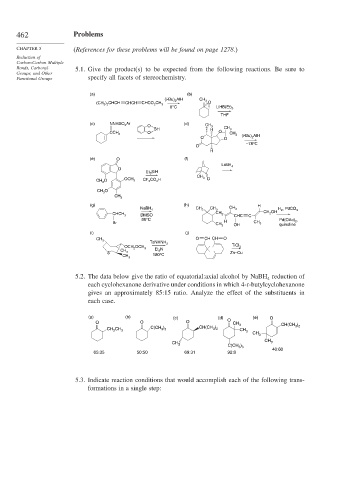Page 489 - Advanced Organic Chemistry Part B - Reactions & Synthesis
P. 489
462 Problems
CHAPTER 5 (References for these problems will be found on page 1278.)
Reduction of
Carbon-Carbon Multiple
Bonds, Carbonyl 5.1. Give the product(s) to be expected from the following reactions. Be sure to
Groups, and Other
Functional Groups specify all facets of stereochemistry.
(a) (b)
(i-Bu) 2 AlH CH 3
(CH 3 ) 2 CHCH CHCH CHCO 2 CH 3 O
0°C LiHB(Et) 3
THF
(c) NNHSO 2 Ar (d)
O CH 3
BH H CH 3
O O
CCH 3 CH 3 (i-Bu) 2 AlH
O O
–78°C
O
H
(e) O (f)
LiAlH 4
O
Et 3 SiH
CH 3
CH 3 O OCH 3 CF 3 CO 2 H O
CH 3 O
CH 3
(g) (h) H
CH 3
NaBH 4 CH 3 CH 3 H 2 , PdCO 3
CH 2 OH
CHCH 3 DMSO CH 2 CHC C
85°C H Pd(OAc) 2 ,
Br CH 3
CH 3 OH quinoline
(i) (j)
O CH CH O
CH 3
TsNHNH 2
TiCl 3
Et 3 N
OCH 2 OCH 3
S CH 3 180°C Zn–Cu
CH 3
5.2. The data below give the ratio of equatorial:axial alcohol by NaBH reduction of
4
each cyclohexanone derivative under conditions in which 4-t-butylcyclohexanone
gives an approximately 85:15 ratio. Analyze the effect of the substituents in
each case.
(a) (b) (c) (d) (e) O
O O O O
CH 3
CH(CH 3 ) 2
C(CH 3 ) 3 CH(CH 3 ) 2
CH 2 CH 3
CH 3
CH 3
CH 3
CH 3
C(CH 3 ) 3
40:60
65:35 50:50 69:31 92:8
5.3. Indicate reaction conditions that would accomplish each of the following trans-
formations in a single step:

